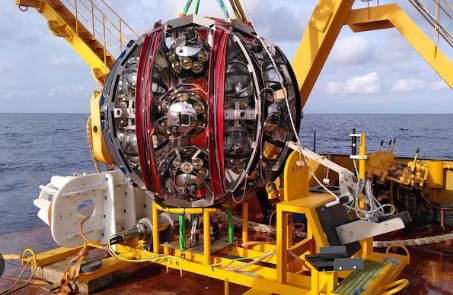A groundbreaking discovery has just made waves in the world of high-energy astrophysics. For the first time, a neutrino with an unprecedented energy level has been detected in the Mediterranean by the KM3NeT underwater telescope. Published in the prestigious journal Nature, this scientific breakthrough opens new doors for exploring extreme cosmic phenomena.
This milestone is the result of an international collaboration involving researchers from 21 countries, with Morocco playing a crucial role. Thanks to the commitment of several academic and research institutions, the country has emerged as a major contributor to this cutting-edge scientific endeavor.
KM3NeT, located 3,000 meters deep in the Mediterranean abyss, is an advanced underwater observatory designed to detect the faint light emitted when neutrinos interact with seawater. These elusive particles can pass through matter almost undisturbed, making their detection an extraordinary challenge requiring state-of-the-art technology.
Morocco’s involvement goes beyond scientific research. Two assembly sites have been established in the country for integrating key components of the telescope, positioning Morocco as a strategic hub in the development of KM3NeT’s instruments. In Rabat, digital optical modules capable of detecting the faint trails left by neutrinos are assembled, while in Oujda, electronic circuits are developed to ensure seamless communication within the system.
On February 13, 2023, KM3NeT’s sensors recorded an exceptionally high-energy signal measuring 220 PeV—ten thousand times the energy produced by the world’s most powerful particle collider. Named KM3-230213A, this ultra-energetic neutrino is believed to originate from extreme astrophysical events such as supermassive black holes, supernova explosions, or gamma-ray bursts.
This discovery represents a crucial step in understanding the universe’s most violent phenomena and unraveling the mysteries of the invisible cosmos. Scientists hope that such observations will shed light on the most powerful energy processes in space and deepen our understanding of the nature of cosmic neutrinos.
Morocco’s entry into the KM3NeT collaboration in 2016 marked a turning point in the country’s scientific landscape. By participating in such an ambitious project, Moroccan universities and researchers are positioning themselves as key players in the quest for groundbreaking astrophysical discoveries.
Beyond fundamental advancements, this involvement also presents a unique opportunity for technology transfer and training for the next generation of Moroccan scientists. The project grants young researchers direct access to cutting-edge infrastructure while allowing them to contribute to globally renowned scientific work.
Morocco’s commitment to KM3NeT aligns with a broader strategic vision—one that aims to strengthen scientific innovation, enhance the country’s technological potential, and foster a research ecosystem with global impact.





